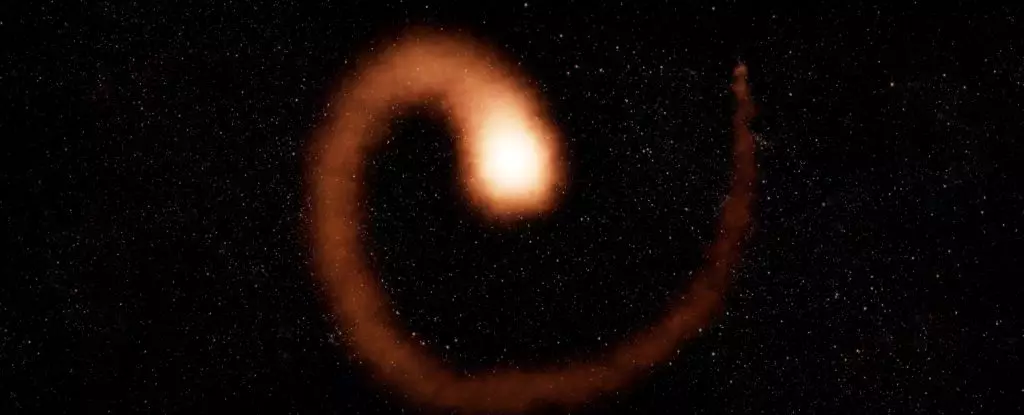In the vast expanse of the universe, the enchanting and perilous beauty of the WR 104 star system captivates astronomers and enthusiasts alike. Commonly referred to as the Pinwheel Nebula, this celestial marvel showcases the dramatic life cycle of a massive star nearing its end, entwined in a complex relationship with its binary companion. This intricate twinning allows researchers to witness not just the violent demise of a star but also the artistry it leaves behind—a swirling spiral of cosmic dust. The excitement surrounding WR 104 is not only due to its visually striking aspects but also because its dynamics offer clues to some of astronomy’s long-standing mysteries.
Research conducted by astronomers, including Grant Hill from the Keck Observatory, provides insight into the two stars’ behavior and orientation. Initial assumptions suggested that WR 104, a hot and luminous Wolf-Rayet star approximately 7 million years old, had a predictable orbital movement aligned parallel to our line of sight. However, astonishingly, the gravitational interactions reveal that this belief was misleading, with the orbital tilt being a staggering 30 to 40 degrees out of view. This unexpected orientation challenges previous understandings of how massive entities interact in deep space.
A Cosmic Stage: The Lifecycle of Wolf-Rayet Stars
Wolf-Rayet stars occupy a unique position in the evolutionary timeline of massive stars. These celestial giants are significantly more massive than our Sun, and their lifespans, albeit short in cosmic terms, are fascinating. Engulfed in fierce stellar winds, these stars lose substantial mass as they approach the end of their lifecycles, paving the way for spectacular cosmic phenomena. When they finally explode into supernovae, they can effectively reshape their surroundings.
In the case of WR 104, the combined forces of its winds and those of its companion star—a luminous OB star nearly 30 times the mass of our Sun—combine to create ethereal structures pivotal to the nebula’s unmistakable spiral pattern. The mechanics of this cosmic dance work like an artist shaping clay; the swirling cosmic dust gets chiseled into a breathtaking spiral, an outcome reflecting the intimate gravitational ballet of the two stars.
The Threat of Gamma-Ray Bursts: A Hidden Dilemma
For some time, the state of WR 104 raised alarms among astronomers. The star was dubbed the “death star” largely because of looming fears about potential gamma-ray bursts emitted during a supernova event. Such gamma-ray bursts, lethal to life on Earth, could devastate our planet if aimed directly at us. The orientation of the stars in relation to Earth has always been a pressing concern, as a direct line of fire would have catastrophic implications for our atmosphere and everything that resides within it.
However, Hill and his team’s groundbreaking revelations have shifted the narrative. By analyzing decades of observational data, they have reassured us that WR 104’s orbital plane is misaligned in such a way that future gamma-ray emissions would not strike Earth. While this is a massive relief, it also raises new questions. If the stars’ poles do not point towards us, then how could the dust trail still appear aligned with our view? This misalignment propels astronomers into uncharted territory, emphasizing the continual need for curiosity in the field; the universe has a way of keeping its secrets close.
The Role of Advanced Observational Techniques
The fascinating revelations about the Pinwheel Nebula underscore the crucial role that advanced observational techniques play in modern astronomy. Powerful infrared telescopes—much like those used at the Keck Observatory—are invaluable in detecting the thermal emissions created by the tumultuous interactions of WR 104’s twin stars. Such tools allow researchers to peer into the dim and enigmatic regions of space, revealing phenomena that could only dream of being seen in the past.
In a field rife with uncertainties, each new observation helps to create a more complete picture of cosmic evolution. The relationship between stars, their interactions, and the visual splendor of their final breath gives us a window into understanding not just their lifespans but also the evolution of galaxies and possibly even the origins of life. WR 104 serves as a reminder of our place within the universe—a tiny speck amid the grand tapestry of stellar creation and destruction.
As scientists delve deeper into the peculiarities of WR 104 and its mysterious relationship with its companion, they are continuously reminded that every answer in astronomy tends to unveil more profound questions. The universe, with all its intricacies and enigmas, remains a vast reminder of nature’s artistic prowess and the relentless pursuit of knowledge.


Leave a Reply